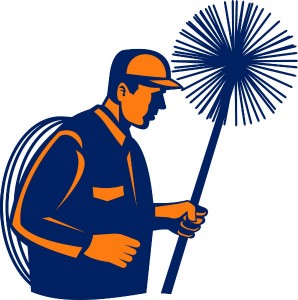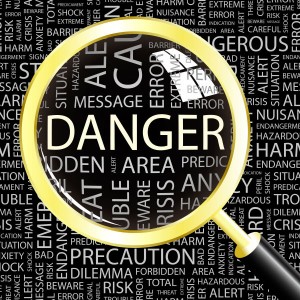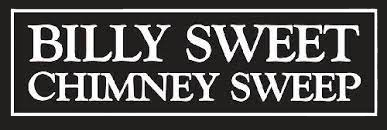by Billy Sweet | Aug 20, 2013 | Chimney Maintenance
Levels of Chimney Inspections
Everyone that has a wood-burning fireplace knows how wonderful they can be in the cooler fall and winter months but your first actions regarding your fireplace should take place long before you build your first fire of the season. A regular chimney inspection should be performed every year to ensure that your chimney is safe and ready to use. Just as all chimneys are not created equal so to can be said about chimney inspections. In fact there are 3 levels of chimney inspection and all have different qualifications on when they should be performed.

Hire a professionally certified chimney sweep to inspect your chimney each year.
The first and most common type of inspection is a Level 1 inspection. This is the type of inspection that should be performed annually to ensure the safety of your fireplace and chimney. This involves basic examination of all accessible chimney components. This includes both exterior and interior components. While some tools may be required to remove coverings or doors to gain access to certain parts of the chimney there is no work done on the actual structural integrity of the masonry unless obvious flaws are visible prompting your chimney sweep to perform a level 2 chimney inspection.
Level 2 chimney inspections are performed when changes are made to the system or some sort of seismic or weather event may have cause damage to the foundation and structure of the chimney and flue itself. It is also recommended that a level 2 inspection be performed if you have moved into a place with a fireplace. The types of changes that can facilitate the performance of a level 2 inspection include changes in the type of fuel being burned in the fireplace as well as changes to the flue or lining (whether it be materials, positioning, etc.). Level 2 inspections usually involve the use of a video scanning system to inspect the entirety of the interior sections of the flue and chimney. It will also include inspection of the exterior portions of the chimney accessible through the attic and/or crawlspaces. If this turns up additional structural issues a level 3 chimney inspection will be performed.
Level 3 chimney inspections involve an extensive inspection of the entirety of the chimney and flue systems. Removal of part of the chimney structure may be required to properly assess the safety and functionality of the fireplace and chimney and will determine the steps necessary to bring the chimney into compliance with safety codes. This type of inspection is used if some serious hazard exists.
Always remember the old adage “It is always better to be safe than sorry”. Have you chimney inspected regularly to make sure that your system is safe and ready to use and avoid a problem that can cost more than just money.
by Billy Sweet | Jul 31, 2013 | Chimney Maintenance
Dangers of Creosote
When a chimney technician comes to your home for a chimney sweeping appointment, the main focus of their job is removing creosote, a byproduct of combustion that builds up on your flue walls as you use your wood-burning fireplace or stove. How does creosote end up in your chimney?

Danger of Creosote – Boston MA – Billy Sweet Chimney Sweep
Hot gases rise in your flue when you light your fires, carrying along various particles; that hot gas hits the less-hot flue walls, and liquid condensation results. That condensation turns into creosote.
You’ll want to have those creosote deposits removed because they’re dirty and smelly, and as the creosote thickens on your flue walls, it can make your chimney less efficient than it could and should be. You need to have creosote removed because it’s highly flammable, and left unchecked, it could lead to a chimney fire. If that happens, best-case scenario, the creosote burns and extinguishes, cracking your flue tiles and leaving you with thousands of dollars in necessary chimney repairs. Worst-case, that fire spreads to the combustible materials in your walls and ceiling, and your chimney fire becomes a home fire.
Creosote build-up is an inevitable part of using a wood-burning fireplace, so safer fireplace use means keeping up with regular chimney sweeping and maintenance.
Different Stages Of Creosote
Creosote develops in three different stages in your flue. Stage one and two creosote, which grades from a more powder-y to a puffy or crunchy consistency, can be removed with standard chimney sweeping practices. (A CSIA-certified sweep will use chimney brushes and tools to remove the creosote from the flue walls and contain it in a specially designed vacuum.)
Stage three, or glazed creosote, is tougher — it builds from layers of sticky, liquid creosote that don’t get an opportunity to dry before another layer develops. Those layers eventually turn into a hard, shiny and extremely stubborn glaze. Chimney technicians have to use chemicals to break down glazed creosote, and cleaning that correctly is an involved, painstaking process. Still, it’s important to have glazed creosote removed, because it’s highly combustible, and very dangerous.
How To Minimize Creosote Buildup
The higher the moisture content in your firewood, the more creosote in your flue. In most cases, chimneys that develop troublesome glazed creosote got that way because the homeowner had been using green, wet wood, which burned cooler, smokier and sootier than proper, seasoned cordwood will.
Failing to open your chimney damper all the way, and allowing a fire to smolder, can also lead to more creosote buildup.
The best approach: Open your damper all the way before you light a fire, and make sure to always use seasoned or kiln-dried cordwood. And even as you’re practicing proper fireplace use, have your chimney swept regularly — cleaner chimneys are safer chimneys.


